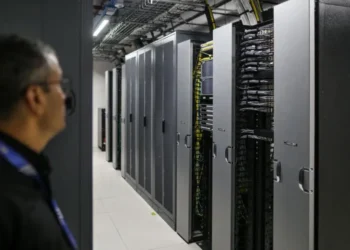Santa Monica Residents Say Waymo Robotaxis Are Driving Them Crazy — Literally
It’s just before midnight in Santa Monica. A masked figure moves through a narrow alley, roll of duct tape in hand. He approaches a parked driverless Waymo taxi, peels off a strip of tape, and quietly disables the car’s sensors.
“We just want the Waymos to stop beeping at night,” he says. “They’re disturbing the whole neighborhood.”
He’s part of a growing group of local residents who call themselves “stackers.” Their mission: disrupt the operations of Waymo’s robotaxi fleet by blocking the vehicles from accessing nearby charging lots. Sometimes they physically obstruct the cars. Other times they experiment with lasers or tape to throw off the sensors. It’s their form of protest — one that’s gotten louder as the cars have, quite literally, beeped their way into residents’ lives.
A Tech Invasion With No Warning
In January, Waymo — the autonomous vehicle company owned by Google parent Alphabet — quietly opened two charging lots in downtown Santa Monica. Since then, around 300 robotaxis have been navigating Los Angeles County, offering driverless rides that many passengers love. But for some locals, the situation is becoming unbearable.
“These things beep, flash lights, and make backup noises all night,” says a resident known as Stacker One, who asked to remain anonymous. “I hear phantom beeps during the day now — even when I’m not home.”
Others have likened the noise to a Las Vegas light show, complete with loud vacuums, revving motors, and human attendants moving in and out of the alleyways to clean and charge the vehicles.
Legal Gray Areas and Bamboo Band-Aids
Waymo has made small changes in response to the complaints:
- Reduced late-night use of one heavily used lot
- Added quieter vacuums for the staff
- Limited vehicle speed in alleys to 10 mph
- Planted bamboo to muffle sound
But the beeping continues — and residents say it’s not enough.
The city of Santa Monica says the noise isn’t loud enough to violate their sound ordinances. However, residents point to another local rule that bans business operations within 100 feet of a home between 11 p.m. and 6 a.m.
“There’s no clause that says it’s okay if it’s a robot doing the yelling,” says Stacker One.
Who’s in Charge of Regulating Robots?
That question remains murky. According to Santa Monica officials, they don’t have the authority to regulate Waymo’s operations. Autonomous vehicles are governed at the state level by the California Public Utilities Commission (CPUC) and the Department of Motor Vehicles (DMV). But both agencies have limited scopes: the CPUC focuses on passenger safety, and the DMV punts enforcement to local law enforcement.
So who, exactly, can make these cars stop beeping at night? Right now, it seems no one.
Beeping Is the Law — For Now
Ironically, the incessant beeping isn’t a glitch — it’s required by federal safety regulations, which mandate that electric vehicles must emit noise when backing up, just like large trucks.
But residents question whether this makes sense for AI-driven cars, which are loaded with sensors and can detect obstacles in all directions.
“They don’t need to beep,” one neighbor says. “They’re not human. They don’t need to look over their shoulder to see who’s behind them.”
Parking Tickets for Robots, but No Consequences
On a recent afternoon, a Waymo traffic jam formed outside one of the charging lots. A Santa Monica parking officer started handing out tickets — not to humans, but to driverless cars.
Ironically, the only penalty Waymo cars can receive is for parking violations. Under current California law, they can’t be issued traffic tickets, even when caught rolling through stop signs.
That might change. Lawmakers are now considering a bill that would allow robotaxis to receive fines and points just like human drivers. But critics ask: will a $300 ticket matter to a billion-dollar tech company?
The Bigger Question: Can AI and Humans Coexist Peacefully?
For people like Grayson Small, a musician who lives nearby, the robotaxis aren’t just an annoyance — they raise deeper concerns about safety and public oversight.
“I watched a Waymo roll right through a stop sign,” he said. “What if I was walking my dog? What if I had my kid with me?”
Small believes innovation is great — but not at the expense of human happiness and safety. “What’s the point of doing things we’ve never done before if it makes our lives worse?”
No Public Input, No City Meetings
Residents say they weren’t asked before the charging stations were set up, and no public consultation ever took place.
“I asked to speak at a city council meeting,” says Nancy Taylor, another local resident. “They told me Waymo had a waiver. There wouldn’t be a meeting.”
Even after reaching out to various departments, residents say their complaints fell on deaf ears.
“We didn’t start by protesting,” says Stacker One. “We asked nicely. Nobody listened.”
The Tip of the AI Iceberg
This isn’t just a Santa Monica problem. It’s a preview of a future where AI systems are embedded in daily life — and the rules, responsibilities, and repercussions haven’t caught up.
“This is just the beginning,” warns Hamid Ekbia, director of the Autonomous Systems Policy Institute at Syracuse University. “The public needs to be involved before these technologies are deployed.”
And he worries that many new AI systems won’t be as visible — or protestable — as a beeping car in your alley.
“We need to slow down,” he says. “And ask: what’s the rush?”
This article was rewritten by JournosNews.com based on verified reporting from trusted sources. The content has been independently reviewed, fact-checked, and edited for accuracy, neutrality, tone, and global readability in accordance with Google News and AdSense standards.
All opinions, quotes, or statements from contributors, experts, or sourced organizations do not necessarily reflect the views of JournosNews.com. JournosNews.com maintains full editorial independence from any external funders, sponsors, or organizations.
Stay informed with JournosNews.com — your trusted source for verified global reporting and in-depth analysis. Follow us on Google News, BlueSky, and X for real-time updates.













